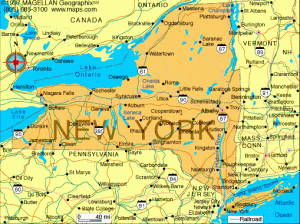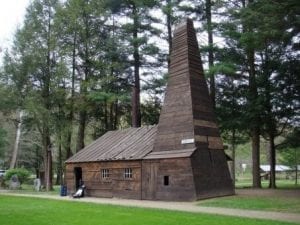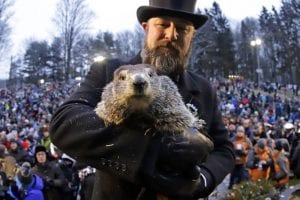
Day 35: Rumbling Through the Rust Belt
April 23, 2021
Day 33: Water, Power and Pollution
April 21, 2021Most recently updated on February 4, 2024
Originally posted on April 22, 2021
Comedy, oil, groundhogs and a solemn memorial.
We’ll hit all those things as we venture out of New York and back into Pennsylvania on our journey today.
From Buffalo, we roll along the southeastern shores of Lake Erie on Interstate 90 for nearly an hour before we head south on Highway 60.
Here’s we enter some of the richest agricultural acreage in New York. You can envision pioneers on their way to the Ohio Valley stopping, saying “this is good enough” and putting down stakes.
The region’s top agricultural commodity is milk, but the area also produces a significant amount of Concord grapes. A lot of jelly as well as wine is made here, too.
Along Highway 60, we glide by Chautauqua Lake, a 13,000-acre body of water that sits at 1,308 feet elevation. That makes it one of the highest navigable lakes in North America. Its maximum depth is 75 feet and its water drains southward, eventually reaching the Ohio and Allegheny rivers. The lake is mostly used for recreation and fishing, including ice fishing in the winter.

As we pass the southern tip of the lake, we enter Jamestown, a community of nearly 28,000 people near the Pennsylvania border.
The city is named after James Prendergast, one of its first settlers. In 1806, his family purchased 3,500 acres here and in 1808 bought another 1,000 acres. Prendergast put up a log cabin in 1810, the first building in Jamestown.
The town has had a number of diverse industries over the years.
In the 1820s, it was a major producer of pearl ash used in glass manufacturing.
In 1860, the Atlantic and Great Western Railroad arrived, giving Jamestown a link to New York and Pittsburgh.
In 1887, Jamestown Lighting and Power was established. In 1888, the Jamestown Woolen Spinning Company was created. In 1900, the Hall Textile Corporation began operations.
In 1907, the Crescent Tool Company was formed and developed the popular crescent wrench.
The Automatic Voting Machine Company produced automatic voting machines with levers. They were in business until 1984 when the firm went bankrupt due to the switch in the mid-1900s to paper ballots.
Jamestown also had a strong lumber industry due to the plentiful timber in the nearby forests. By 1830, the city was shipping 40 million board feet of lumber per year. The supply of wood allowed the furniture industry to develop.
By 1930, the town had 50 furniture factories. Swedish immigrants worked in the plants and became the city’s largest ethnic group in the 1920s. Jamestown was once the country’s second largest furniture manufacturer behind only Grand Rapids, Michigan. People from all over the country used to visit the Furniture Mart for its semi-annual expositions until 1982. The building still stands and has been used for offices. There are plans now to remodel it with residential units on the top floors along with commercial space and hotel rooms on the lower floors.
The city’s furniture industry declined after 1940 due to the waning supply of nearby timber as well as labor-management disputes and the lack of capital to modernize facilities.
Today, the major employers in town are manufacturers such as Hope’s Windows Inc. and Bush Industries, which produces ready-to-assemble furniture.

The National Comedy Center in downtown Jamestown, New York. Photo by the National Comedy Center.
Jamestown is also home to the National Comedy Center, which opened in August 2018. There are more than 50 exhibits that detail the history of comedy from vaudeville to present day. The daughter of comedian George Carlin has donated a number of items. Visitors can create a humor profile so they can be guided through exhibits tailored to their tastes.
You may ask: Why is the National Comedy Center located in Jamestown?
There is a simple answer. The city is the hometown of comedian Lucille Ball.
Ball was born in Jamestown in 1911. Her family was poor and moved constantly, always returning to Jamestown after a misadventure somewhere else.
Ball’s career began as a model, at first for a hat company and then Chesterfield cigarettes. She eventually dyed her blonde and moved to Hollywood, where she found some bit roles in 1930s and 1940s movies. On one of those movie sets, she met Cuban bandleader Desi Arnaz. The two fell in love and married.
Ball had dyed her hair red by then and was looking for a career change away from film. She and Arnaz put together a vaudeville act called “I Love Lucy.” The act eventually caught the eye of CBS and the couple was signed to produce their “I Love Lucy” television show. The comedic program debuted in 1951 and ran for six seasons, becoming one of television’s comedy classics.

A replica of an “I Love Lucy” set at the Lucille Ball Desi Arnaz Museum in Jamestown, New York. Photo by I Love NY.
One of the show’s episodes did make reference to the region where Ball grew up. In the scene, Ball’s character, Lucy, finds a mounted fish in the attic and recalls that Arnaz’s character, Ricky, caught the fish at Chautauqua Lake.
The success of “I Love Lucy” is the focus of the Lucille Ball Desi Arnaz Museum. The complex, just a couple of blocks from the National Comedy Center, opened in 1996. Its stated mission is to “preserve the legacy of Lucy and Desi and enrich the world through the healing power of laughter.” The center contains artifacts from the couple’s life as well as replicas and actual sets, clothing and other items from their 1950s television show.
Ball’s childhood home still stands in Jamestown. There are also several statues of her around town. Ball is buried in Lake View Cemetery here. You can find her gravesite by following the red hearts, a signature motif from her television show.
Oil and Groundhogs
We head out of Jamestown by taking Main Street south and staying that course until we cross into Pennsylvania, leaving New York after a 3-day tour and entering the Keystone State for a third time, the only state on our trip that will get that many visits.
Eventually, we take Highway 6 west and then Highway 27 southward.
An hour after leaving Jamestown, we arrive at Titusville, a town of less than 600 people that nonetheless holds an important place in U.S. energy history.
The community was founded in 1796 by Jonathan Titus and Samuel Kerr, two surveyors from the Holland Land Company.
In its early years, Titusville was built on the lumber and agricultural industries. At one time, the town had 17 saw mills as well as plastic and tool manufacturing facilities.

However, there was another industry literally waiting at people’s feet.
Oil had been seeping from the ground here for centuries. The Seneca tribe used the sticky liquid as a salve. European settlers applied it as a treatment for sprains and other ailments.
Until the mid-1800s, whale oil had been used to light lamps, but it had become expensive, so a replacement had been sought.
The presence of large underground petroleum fields in Titusville was discovered in the 1850s. However, there was no economical way to extract it.
So, the Seneca Oil Company sent Edwin Drake to start drilling on a piece of land south of Titusville. Drake hired a salt well driller in summer 1859. On August 27, they struck oil at a depth of only 69 feet, becoming the first successful oil well in the United States.
Other wells sprung up quickly. In that initial year, the region produced about 4,500 barrels of oil. By 1862, it hit 3 million. The early batches were mostly used to make kerosene for lamps.
The Oil Creek and Titus Railroad was completed in 1862 from Titusville to Corry, a town 25 miles to the north. The railway linked up with major east-west routes. In 1866, pipelines were laid directly to the rail lines. Eight refineries were built between 1862 and 1868.
The country’s first oil exchange was established in the region in 1871. Jonathan Watson, who owned the land where the Drake well was drilled, became the world’s first oil millionaire.

The Drake Well Museum and Park in Titusville, Pennsylvania, commemorates the first successful oil well in the United States. Photo by Atlas Obscura.
Natural gas was discovered in 1872. Other industries related to oil and gas bloomed. Titusville grew from 250 to 10,000 people almost overnight.
The oil industry here peaked in 1891, but it still remained strong for decades. The emergence of electricity threatened to diminish the oil industry’s future, but the advent of the automobile ignited another demand for the product.
The oil industry went on for another half-century before petering out. The last oil refinery in Titusville closed in 1950. However, the town is still regarded as the birthplace of the U.S. oil industry.
The economy today features steel, plastics and aluminum casting industries.
The city’s oil history is spotlighted at the Drake Well Museum and Park, which sits along Oil Creek. The 240-acre property displays a reconstruction of that first oil well. The museum highlights the history and importance of the oil industry.
The other prominent museum in town is the Ida Tarbell House. This is where the journalist Ida Tarbell lived as a child from 1870 to 1876, when she graduated from Titusville High School. Tarbell wrote ground-breaking articles on John D. Rockefeller’s Standard Oil Company for McClure’s magazine between 1902 and 1904. Those stories led to congressional action in 1911 to break up Standard Oil under the Sherman Anti-Trust Act. Tarbell is an inductee in the National Women’s Hall of Fame back in Seneca Falls, New York.
Another icon of journalism here is now gone.
In November 2022, the Titusville Herald closed its doors. The local newspaper had been in operation since 1865.
——————————————–
We continue our tour of western Pennsylvania by heading south on Highway 27 and then continuing in the same direction on Highway 36.
Along the way, we cruise by the western edge of the Allegheny National Forest.
This 517,000-acre preserve is Pennsylvania’s only national forest. About 463,000 acres are forest while 42,000 acres are non-forest and 11,000 acres is water.
The highest elevations are at 2,300 feet while the lowest in the valleys sit at 1,000 feet. The forest contains about 600 miles of trails and 700 miles of streams.
In the 1700s, the region was an old growth forest with mostly hemlock and beech trees. It was filled with wolves, cougars, deer and other animals. Native tribe members burned small areas of the forest for passages and hunting.
In the 1800s, European settlers cut trees to build homes and clear land for agriculture. A number of saw mills and tanneries opened, increasing the demand for timber.

The Allegheny National Forest is Pennsylvania’s only national forest. Photo by HipWallpaper.
In the 1900s, the wildlife population in the Allegheny woods had been nearly wiped out. The federal government stepped in and established the national forest in 1923. The trees have regrown quickly since then. The land is now mostly second growth forest.
The forest sits in the midst of Pennsylvania’s oil and gas deposits. In the early 1980s, about 17 percent of the state’s crude oil production came from mineral rights owned by private individuals within the forest’s boundaries. That has created some conflicts over the years that have ended up in the courts.
The motto for the forest is “Land of Many Uses” as the trees provide material for a number of wood products while at the same time offering recreation for human visitors as well as a watershed and wildlife habitat for its animal life.
The southbound drive on Highway 36 continues for another hour before we reach the small town of Punxsutawney.
The community of 5,500 people is on the news every February 2 because of its infamous Groundhog Day celebration.
Before the groundhog, though, Punxsutawney was known for its gnats.
The region was occupied for centuries by the Shawnee, Seneca, Lenape and Iroquois tribes. The Delaware tribe settled in large numbers here in 1723.
The first European settler was the Rev. John Ettwein, who brought Christian-converted Delaware tribe members to the village in 1772.
At that time, the area was filled with gnats from the local swamps. In fact, the name Punxsutawney comes from the Native American phrase that means “town of the sandflies.”
Future settlers eventually drained the swamps and got rid of the gnats as well as the mosquitos. They started coal mining and lumber ventures. In the mid-1800s, factories were established for brickworks, glassworks, lumber, tanning, iron works, silk, flour and feed.

Groundhog Day in Punxsutawney, Pennsylvania, in 2019. Photo by The Guardian.
By the 1930s, the factories were gone. Many of the jobs in town today are centered at Baltimore & Ohio Railroad repair yards and a meat packing plant. Oh, there’s the tourism industry, too.
Punxsutawney is, of course, best known for its Groundhog Day celebration on the second day of February at Gobbler’s Knob, a wooded hilltop just outside of town.
Groundhog Day began in the United States and Canada around 1840. It evolved from a German tradition that claimed that if a groundhog (or hedgehog or badger) saw its shadow in early February, that meant six more weeks of winter.
The first Groundhog Day in Punxsutawney was held in 1886. The groundhog Punxsutawney Phil was introduced in 1961. Local folks like to spread the whimsical myth that Phil is 100 years old, but in reality groundhogs usually live only six or seven years.
The Groundhog Day crowds in Punxsutawney used to number about 1,500. However, after the 1993 movie “Groundhog Day” starring Bill Murray premiered, the audience swelled to 30,000.
February 2 isn’t the only time you can see Punxsutawney Phil. He and his mate, Phyllis, live in a climate-controlled room called Phil’s Burrow at the city library. You can view both groundhogs through outside windows all year round.
Punxsutawney Phil was on the Oprah Winfrey show in 1995. He got his own website in 1996 and had his February 2 prediction broadcast live on the big screen in New York City’s Times Square in 2001.
The 1993 movie was actually filmed in Woodstock, Illinois, but Bill Murray did visit Punxsutawney in 1992 while doing research for the film. The Pantall hotel where the actor stayed had a Bill Murray suite before it closed down in 2013. The shuttered hotel got new owners in 2020 who hope to restore the building to its previous glory under a new name, The Shadow Hotel. It’s scheduled to reopen in January 2025.
The Field Where It Happened
We’ll spend the next 1 hour and 45 minutes driving due south of Punxsutawney, winding through the wooded hills of western Pennsylvania.
Along the way, we pass through the town of Jerome, a community of 700 people that sits at an elevation of nearly 1,800 feet.
The settlement was founded in 1904 as the epitome of a company town.
Hillman Coal and Coke Company operated a coal mine in the region that employed as many as 1,000 people in its heyday. Many of those workers were immigrants from eastern Europe. A number of them had vegetable gardens and wine-making facilities.
The company built housing for its employees. Many of those homes still stand today.
Hillman also constructed a 300-seat theater, a bank, a hotel, a YMCA, an automobile dealership and a company store.
The coal mine closed in 1954. A garment factory was active in town from 1955 to 1964. A lumber mill operated in the 1970s.
After another 20 minutes of southward travel, we reach Shanksville, a community of less than 200 people.
If the town sounds familiar, it’s probably because you heard it mentioned on September 11, 2001.
It was on that day that United Airlines Flight 93 flying from Newark, New Jersey, to San Francisco, California, slammed into the ground in a field about two miles north of the small town.

The 93-foot-high Tower of Voices in Shanksville, Pennsylvania, remembers the 40 civilians who died in United Flight 93 crash on September 11, 2001. Photo by the Noun Project.
It was one of four commercial airliners hijacked by terrorists that morning. Two planes were flown into the World Trade Center towers in New York City. A third jetliner crashed into the Pentagon in Arlington, Virginia.
Air traffic controllers said they first learned of the hijacking of this fourth plane from a conversation they could hear in the cockpit near Cleveland, Ohio. The plane turned southward toward Washington, D.C., shortly after that.
Passengers on Flight 93 used mobile phones to report the takeover of their plane. In the process, they learned about the three other plane crashes that morning.
It’s believed some of the passengers tried to recapture the plane, leading the terrorists who were piloting the aircraft to intentionally crash the jetliner.
The plane hit the ground at more than 500 miles per hour. It was about 20 minutes away from Washington, D.C., at that time. Investigators believe the terrorists’ target was the U.S. Capitol building.
All 33 passengers as well as seven crew members and four terrorists were killed.
The crash site is home to the Flight 93 National Memorial. The 2,200-acre preserve contains a Wall of Names memorial on a hill near where the plane crashed. It also has a 93-foot Tower of Voices with 40 wind chimes representing the 40 civilians who died.
There have also been 150,000 trees planted around the area.
The memorial was dedicated in September 2011 on the 10-year anniversary of the crash. In 2015, a museum and visitors’ center were opened. On September 11, 2021 the center was visited by President Joe Biden and Vice President Kamala Harris, along with others. Former President George W. Bush was among those who spoke.
In the town itself, there is a 2-ton, 14-foot-high cross made of steel from the World Trade Center at the Shanksville Volunteer Fire Department. The monument was dedicated in 2008.
There are no motels in Shanksville, so if you’re spending the night you need to drive to Somerset, a borough of nearly 6,000 people just west of the crash site.
Along the way, you pass the UAL Flight 93 Memorial Chapel on the thoroughfare between the two towns. The church has flags, a memorial for the Flight 93 crew and personal items from the passengers as well as the World Trade Center. There is also a meditation room with biographies of the 40 passengers and crew.
The pastor who started the memorial welcomed people of all religions to his church, which was built in 1902. The Rev. Alphonse Mascherino died of cancer in 2013, but the memorial continues on.
We’ll stop here for today to remember and reflect.
Tomorrow, we’ll take a tour through numerous towns that were built on steel before they faded from glory. One of them is a well-known big city in western Pennsylvania that is reinventing itself.


